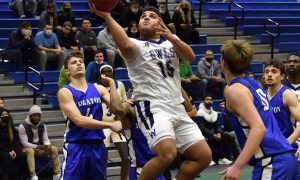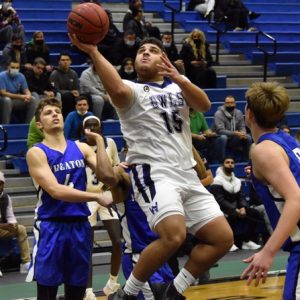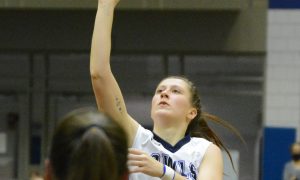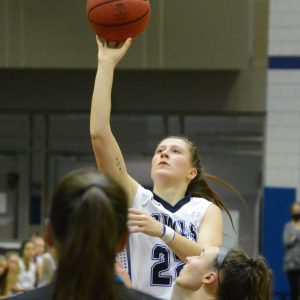
Forbasaw Nkamebo (left) and Jill Valley (right) were both first team All-MASCAC selections this season. (Photo courtesy of Westfield State University Sports)
WESTFIELD – When Westfield State women’s basketball coach Andrea Bertini told her players that they’d be using ‘The Grinnell System’ this season, they thought she was crazy.
The Owls were coming off of a 24-win season in which they had a 16-game winning streak and finished undefeated in MASCAC play, finishing minutes shy of an NCAA Tournament berth. Now, Bertini wanted to completely overhaul her team’s style of play.
The System was created by David Arseneault, the former head men’s basketball coach at Grinnell College in Iowa, and became well-known in basketball circles for its revolutionary approach to the game. Arseneault’s style of play didn’t gain mainstream recognition, however, until 2012, when Grinnell guard Jack Taylor set an NCAA record by scoring 138 points in a single game.
Arseneault uses a mathematical formula to describe his system, but the goal is simple: press and trap all over the court, on every possession; push the ball up the floor as fast as possible, taking the first available layup or three-point shot; make wholesale substitutions every 45 seconds to a minute, in order to maintain the frenetic pace of play.
This is the formula, as reported by Stan Grossman of The Boston Globe: 94 S + 47 3’s + 33 %+ 25 SD + 32 TO’s = W.
It means if the Owls shoot 94 times, with 47 of those shots being three-pointers, rebound 33 percent of heir misses, shoot 25 more times than their opponent, and force 32 turnovers, they have a 95% chance to win.
In order to play this way, every player on the team has to buy in. The pace is exhausting, forcing frequent hockey-style substitutions. Coaches must rely on contributions from deep off the bench, and players used to playing 30 minutes per game must get accustomed to playing half that.
At first, junior guard Jill Valley (Orange, Mass.) and the returning players were skeptical of their coach’s new ideas. They tried out the approach in summer workouts, but were hardly convinced the system would work.
“We thought she was crazy,” Valley said. “We were used to playing the whole game, and now coach was telling us she was going to sub us out every minute, and we were supposed to shoot 40 threes a game.”
But Bertini saw how the system could fit her current roster. She was returning Nkamebo, a first team all-conference performer and the most athletic center in the conference. She had two guards, Valley and Kirsy Segarra (Holyoke, Mass.), who were not only knock down three-point shooters, but elite defensive players as well. She had a junior point guard, Alyssa Darling (Palmer, Mass.), who could run the show and push the tempo, and she had a deep roster, including a talented freshman class.
“After the [MASCAC] finals last year, I put a lot of reflection on how I wanted to play,” Bertini said. “I did a lot of research in the spring because I wanted to do something different. I wanted more players getting experience, more players playing, more players feeling a part of it, while at the same time, maximizing the talent that I thought we had.”
Still, the system goes against nearly everything basketball players have been taught since biddy ball, and it took the players awhile to adjust to a new way of playing. During a 1-3 start, which included a 29-point home loss to Keene State, players, fans, even Bertini herself, harbored some doubts about the system.
“I think back to the Keene State game, when we got blasted by 30, and I just remember the doubt,” Bertini said. “That was probably the game where I went home that night going, ‘what am I doing?’ But then I quickly turned on my Irish-Italian stubbornness, and said forget it, we’re just going to keep doing this.”
After the loss to Keene State, Bertini received emails from Doug Porter, a top assistant for the women’s basketball team at North Central College (IL), and Bob Belf, an assistant coach at Grinnell. Both coaches employed the same system, had seen the game, and offered Bertini suggestions on where the Owls could improve.
There was a small fraternity of coaches who ran the system, and Bertini found out many were more than willing to help a fellow coach trying to install it in their program. Bertini exchanged emails with Arseneault himself over the summer, and has bounced ideas back and forth with coaches such as Michelle Roof, an assistant at North Central, Lauren Stamatis, the head women’s coach at Olivet Nazarene (IL), and Paul Culpo, the men’s coach at Castleton University (VT).
The tide started to turn in a win over UMass Boston, a team that finished the season 16-12 and advanced to the Little East Conference championship, on December 10 heading into winter break. Westfield forced 34 turnovers and defeated the Beacons, 91-79.
“At first, we all hated it,” Segarra said. “After winter break, I think it all started to click.”
Westfield State won its first five games of the calendar year, and has now won 17 of its past 20 games. The Owls finished 11-1 in conference play, and defeated Framingham State in the MASCAC championship.
“Getting into the flow was hard [at first],” said Nkamebo, who earned MASCAC Tournament MVP honors. “We didn’t think we had enough time for us to play how we normally play. We’re all scorers and we only play for a minute, so when we’re on the same shift, we felt like there wasn’t enough time for us to all get our shots. But then we started to get the chemistry.”
As they board the bus heading to Bowdoin College in Brunswick, Maine for a first round NCAA Tournament game Friday, the Owls rank third in the NCAA in points per game (89.7) and first in offensive rebounds per game (23), turnovers forced (34.19), steals (20.6), and turnover margin (+13.89).
Westfield State attempts more than 86 field goals and 26 three-pointers each game. No player plays more than 19 minutes per game, yet the Owls boasted the MASCAC’s top four scoring leaders in points per 40 minutes. Bertini consistently plays 15 to 16 players in each game, often with more than 10 players scoring.
Despite playing just 19 minutes per game, Valley ranks second in the MASCAC with 17.3 points per game and earned conference Player of the Year honors. Nkamebo, a repeat first team all-conference selection, actually averaged more points per game this season (15.1) than last season (14.7) in 10 fewer minutes per game.
The Owls play a fun brand of basketball and with nearly everybody on the roster producing valuable contributions each game, it is a cohesive team. Westfield plays with a freedom and excitement that you don’t always see in pressure-filled collegiate games.
Whether it’s a preseason scrimmage or the MASCAC championship, the Owls can be seen dancing and singing along to the pregame warm up music, laughing and cheering each other on during play.
“They’ve all bonded in a way that I was hoping, because they’re into it, they’re energized,” Bertini said. “Other teams at this stage of the season are often worn down. It’s different, there’s more life..you can just see there is an overall excitement.”
“Now, I don’t know how to play regular basketball,” Valley added. “Now, when we’re watching a regular game, we’re like, ‘this is boring’.”
This season, as the Owls fly up and down the court, one word that definitely will not be used to describe them is boring. – Courtesy of Westfield State University Sports







